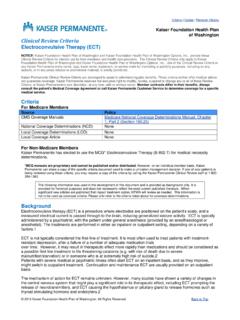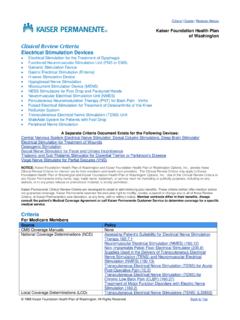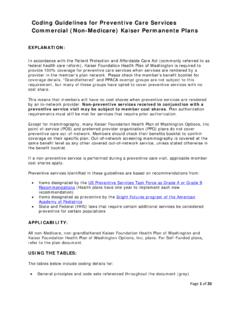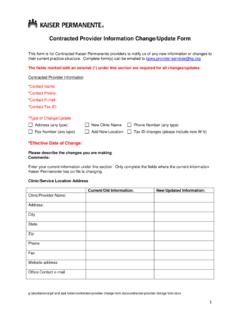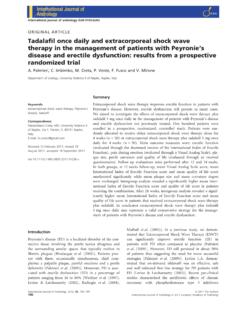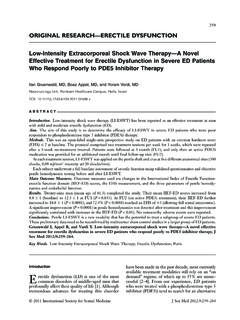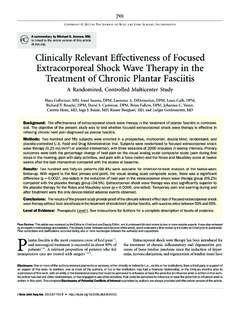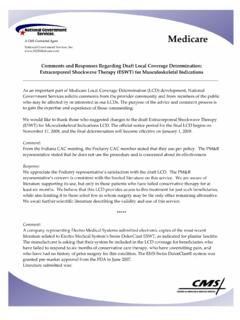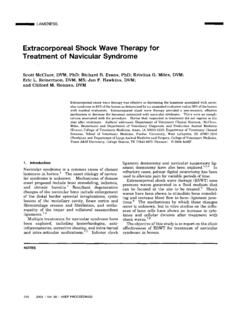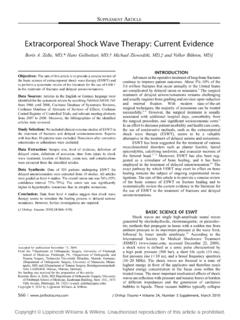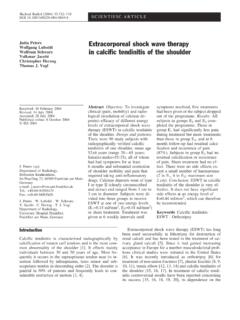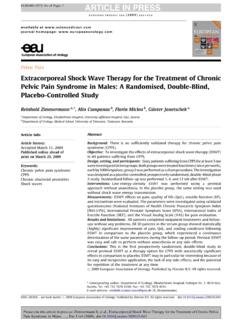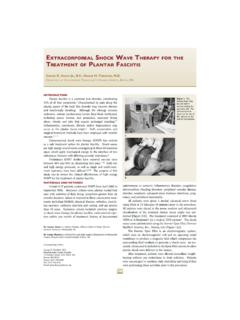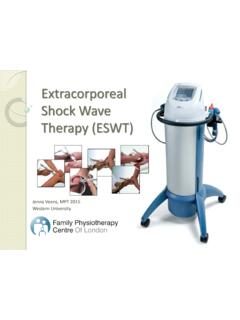Transcription of Extracorporeal Shockwave Therapy (ESWT) | Clinical Review ...
1 Criteria | Codes | Revision History Kaiser Foundation Health Plan of Washington Clinical Review Criteria Extracorporeal Shock Wave Therapy (ESWT). Chronic Plantar Fasciitis Lateral Epicondylitis (Tennis Elbow). Non-Union or Delayed Union Fractures NOTICE: Kaiser Foundation Health Plan of Washington and Kaiser Foundation Health Plan of Washington Options, Inc., provide these Clinical Review Criteria for internal use by their members and health care providers. The Clinical Review Criteria only apply to Kaiser Foundation Health Plan of Washington and Kaiser Foundation Health Plan of Washington Options, Inc. Use of the Clinical Review Criteria or any Kaiser Permanente entity name, logo, trade name, trademark, or service mark for marketing or publicity purposes, including on any website, or in any press release or promotional material, is strictly prohibited. Kaiser Permanente Clinical Review Criteria are developed to assist in administering plan benefits.
2 These criteria neither offer medical advice nor guarantee coverage. Kaiser Permanente reserves the exclusive right to modify, revoke, suspend or change any or all of these Review Criteria, at Kaiser Permanente's sole discretion, at any time, with or without notice. Member contracts differ in their benefits. Always consult the patient's Medical Coverage Agreement or call Kaiser Permanente Customer Service to determine coverage for a specific medical service. Criteria For Medicare Members Source Policy CMS Coverage Manuals None National Coverage Determinations (NCD) None Local Coverage Determinations (LCD) For Codes 0101T and 0102T - Non-Covered Services (L35008). For CPT Code 28890 - Due to the absence of a NCD, LCD, or other coverage guidance, KPWA has chosen to use their own Clinical Review Criteria, Extracorporeal Shock Wave Therapy (ESWT), for medical necessity determinations. Use the Non- Medicare criteria below.
3 Local Coverage Article None Non-Medicare Members Indication Policy Chronic Plantar Fasciitis There is insufficient evidence in the published medical literature Lateral Epicondylitis (Tennis Elbow) to show that this service/ Therapy is as safe as standard Non-Union or Delayed Union Fractures services/therapies and/or provides better long-term outcomes than current standard services/therapies. The following information was used in the development of this document and is provided as background only. It is provided for historical purposes and does not necessarily reflect the most current published literature. When significant new articles are published that impact treatment option, KPWA will Review as needed. This information is not to be used as coverage criteria. Please only refer to the criteria listed above for coverage determinations. Evidence and Source Documents Extracorporeal Shock Wave Therapy (ESWT) for Delayed or Nonunion Fractures Extracorporeal Shock Wave Therapy (ESWT) for Chronic Plantar Fasciitis Extracorporeal Shock Wave Therapy (ESWT) for Lateral Epicondylitis Background Extracorporeal shock waves are characterized by high positive pressure with a rapid rise time and short (microsecond) duration.
4 The shock waves are concentrated into small focal areas of 2 to 8 mm to optimize therapeutic affects and minimize the impact on adjacent tissues. There are several types of shock wave generating systems; they can involve electrohydraulic, electromagnetic or piezoelectric mechanisms. The shape of 2001 Kaiser Foundation Health Plan of Washington. All Rights Reserved. Back to Top Criteria | Codes | Revision History the pulses differs depending on the mechanism. In all of the systems, shock waves are concentrated by focusing reflectors on the target site. The shock waves can be further localized using imaging modalities such as ultrasound. Beneficial effects are expected to be observed between 6-12 weeks after treatment (Speed 2004;. Wilner & Strash, 2004). Extracorporeal shock wave Therapy (ESWT) is used an a non-invasive alternative to surgery for patients with chronic plantar fasciitis who have not responded to conservative Therapy such as use of orthotics, physical Therapy , night splints, heel cups and treatment with non-steroidal anti-inflammatory drugs (NSAIDs).
5 Plantar fasciitis is believed to result from a biochemical imbalance that places abnormal tension on the plantar fascia which leads to inflammation and tension on the calcaneal periosteum. The mechanism by which ESWT relieves symptoms of plantar fasciitis is not known; however, there may be an effect through tissue disruption of the tendinous fibers followed by neovascularization and replenishment of the extracellular matrix (Atkin, 1999; Wilner & Strash, 2004). The HealthTronics OssaTron (October, 2000), Dornier Epos Ultra (January, 2002), Medispec Orthospec (April, 2005) and Orthometrix Orbasone (August, 2005) devices have all been approved by the FDA for the treatment of chronic proximal plantar fasciitis in individuals aged 18 or older who have a history of unsuccessful conservative treatments. The OssaTron and Orbasone are electrohydraulic devices, the Epos Ultra uses electromagnetic technology and the Orthospec uses sound waves .
6 Low-intensity ultrasound treatment was approved by the FDA in 2000 for treating non-union fractures. Healing is delayed in approximately 10% of the fractures that occur in the United States. The definitions of non-unions differ, but a fracture is generally considered to be a non-union if it has not healed by 6-9 months. Factors contributing to the occurrence of delayed unions and non-unions include the location and severity of the fracture, the extent of soft tissue damage, adequacy of stabilization or fixation, and lifestyle factors such as smoking and high alcohol intake (Hadjiargyrou et al., 1998; Biederman et al., 2003). Some investigators believe that Extracorporeal shock wave treatment (ESWT) has greater potential for treating delayed union and non-union fractures than ultrasound. Shockwaves are characterized by high positive pressure with a rapid rise time and short duration. Following the high positive pressure is an exponential decrease in pressure.
7 The low-frequency components of shock waves allow them to pass through fluid and body tissues with less energy loss than ultrasound. Thus, shock wave treatment may be better than ultrasound for penetrating tissues and delivering adequate pressure for stimulation of bone growth (Rompe et al., 2001; Speed 2004; Wilner & Strash, 2004). ESWT has not been approved by the FDA for treating non-union or delayed union fractures. The use of shock waves for bone repair has been studied in animal models and initial Clinical studies. Extracorporeal shock wave Therapy (ESWT) is used as a non-invasive alternative to surgery for patients with soft tissue conditions including lateral epicondylitis (tennis elbow). ESWT is generally reserved for patients who have not responded to conservative Therapy such as physical/occupational Therapy , bracing or splinting, local steroid injections and non-steroidal anti-inflammatory drugs (NSAIDs).
8 Lateral epicondylitis is characterized by pain at the epicondyle on the lateral side of the elbow. The etiology is not well known, but it is generally believed to be due to musculotendinous lesions. The onset of pain can occur abruptly after an unaccustomed activity or can develop gradually in individuals who perform activities requiring repetitive and vigorous use of the forearm. Pain is often mild at first but can worsen over time (Buchbinder 2004;. Melikyan, 2003). Medical Technology Assessment Committee (MTAC). Extracorporeal Shock Wave Therapy (ESWT) for Chronic Plantar Fasciitis BACKGROUND. Plantar fasciitis is the most common cause of inferior heel pain characterized by deep pain in the plantar aspect of the heel particularly on arising from the bed in the morning. While the pain may subside with activity, in some patients it persists, interrupting the activities of daily living. Approximately 10% of people develop this condition throughout their lifetime (Riddle and Schappert 2004).
9 While the etiology has not fully been established, it is believed to result from a biomechanical abnormality that places tension on the plantar fascia and leads to inflammation and tension on the calcaneal periosteum. Several risk factors such as bone spurs, pronated foot type, obesity, limb-length discrepancy and weight-bearing appear to increase the risk of plantar fasciitis (Theodore, 2001 Kaiser Foundation Health Plan of Washington. All Rights Reserved. Back to Top Criteria | Codes | Revision History Buch et al. 2004). In the past, conservative therapies for plantar fasciitis, such as rest and stretching, have been successful (Digiovanni, Nawoczenski et al. 2006). Orthotics, physical Therapy , night splints, heel cups and treatment with non-steroidal anti-inflammatory drugs (NSAIDs) have also been used in acute cases. While conservative therapies are successful in 85%-90% of patients (Gill 1997), there remain some persistent cases of plantar fasciitis.
10 Extracorporeal shock wave Therapy (ESWT) is a noninvasive intervention for patients with chronic plantar fasciitis who have not responded to conservative Therapy . Thought to be an alternative to surgical intervention, the mechanism by which ESWT relieves symptoms of plantar fasciitis is not fully understood. The shock waves are believed to stimulate an extracellular response causing neovascularization, promoting tissue repair and regeneration (Atkin, 1999; Wilner & Strash, 2004). Shock waves are characterized by high positive pressure with a rapid rise time and short (microsecond) duration and are concentrated into small focal areas to optimize therapeutic effects and minimize the impact on adjacent tissues. With a variety of devices on the market, shock waves might involve electrohydraulic, electromagnetic or piezoelectric mechanisms and, in each case, the shape of the pulse differs. Beneficial effects are expected to be observed between 6-12 weeks after treatment (Speed 2004; Wilner & Strash, 2004).


